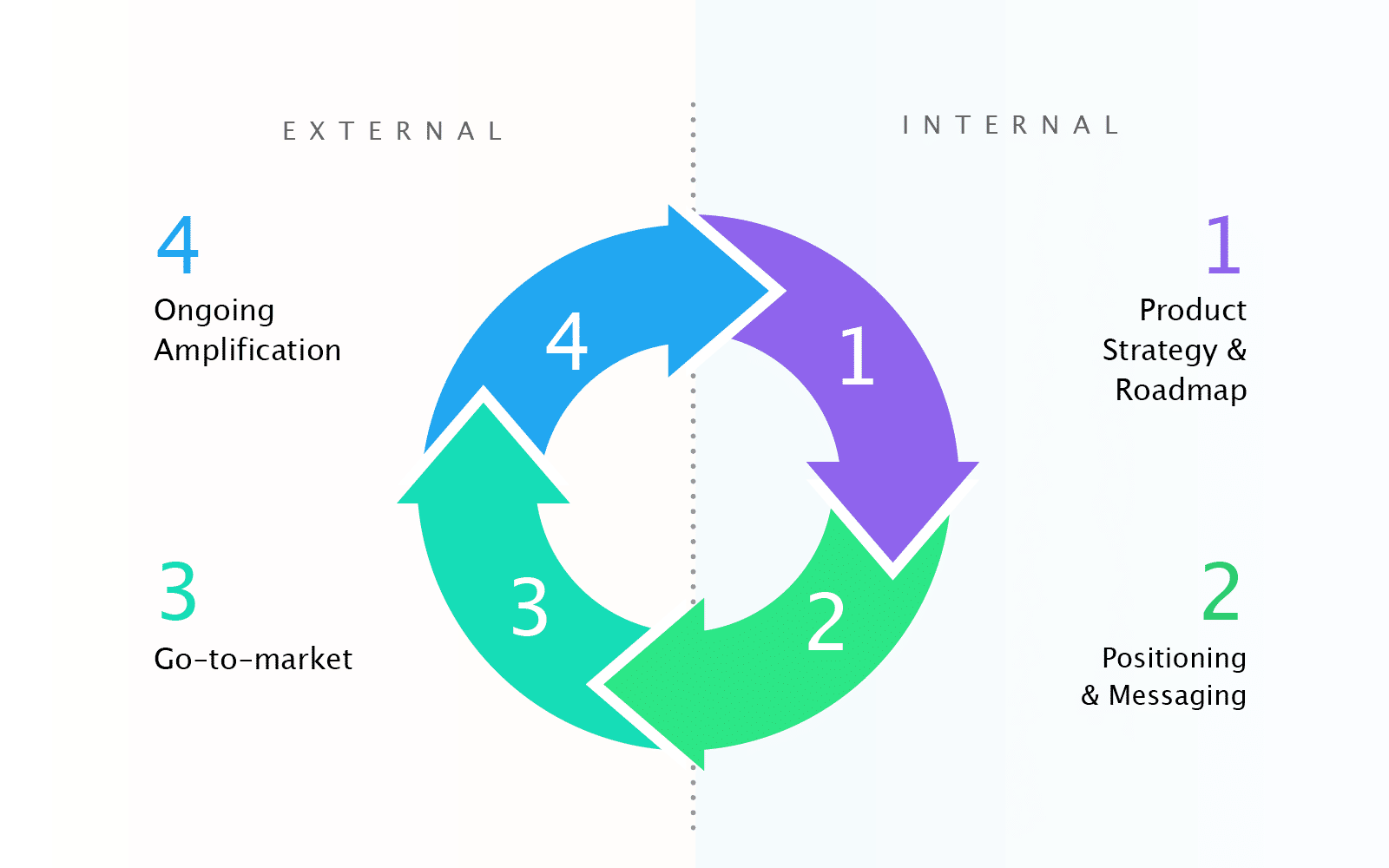While owning a product is good, marketing the product is more important. It can be likened to achieving that dream of becoming a superstar singer while only singing in the shower. That sounds good, right? Now you know how important the concept of product marketing is! This post covers all the basic information you need to understand the concept of product marketing, strategies, examples, jobs, job descriptions, and courses.
The table of content is right below.
Overview of Product Marketing
Basically, Product marketing is bringing your product to the market! It is the process of promoting and selling a product to customers. Also, it is the middleman between product development and increasing awareness leading to sales according to Blogspot.
Literally, we can say it is the act of selling a product pitch to garner new customers and prospects.
This process includes deciding the product’s message, launching, and ensuring sales reps and customers understand it. It aims to increase the demand and usage of the product.
Apparently, stopping product marketing after the launch of the product is like going to the studio to record that our shower song but never launching it.
Well after launch, products are meant to be marketed so it gets the publicity and good clientele base, and feedback it needs to compete effectively in the market with other products.
The Concept of Product Marketing
The truth is, great product means nothing if it doesn’t get the attention of the people who would benefit from it.
In a bid to salvage the situation, there are practical questions you need to ask yourself. Who is your audience for this product? How will you reach them? Where? What is your message to them?
In other words, PM involves understanding the product’s target audience and using strategic positioning and messaging to boost revenue and demand for the product.
So, you have all the work in the world to do!
Product Marketing vs. Traditional Marketing
Product marketing is strategic, whereas traditional marketing is all-encompassing.
Product marketing is a subset of traditional marketing. In fact, if you look at the seven Ps of marketing, you’ll notice that product marketing is one of the most significant components of a company’s marketing activities.
PM is concerned with increasing the demand for and adoption of a product among current customers. It focuses on the processes consumers take to buy your product so that product marketers can create campaigns to support this work.
Understanding a given product’s audience on a deep level and crafting that product’s positioning and message to appeal to that demographic is what product marketing is all about. It includes the launch and execution of a product as well as the marketing strategy for the product, which is why the work of a product marketer is vital to a company’s marketing, sales, and product teams.
Product Marketing vs Product Management
There is a similarity between product marketing vs product management.
We already understand that PM is about creating product and brand awareness. However, Product management starts from creating product specifications, that is, product development/design. It encompasses product marketing and ends at infinity.
Product marketers develop the content for sales, marketing communications, customers, and reviewers for the product. They are at the forefront of all strategies needed to efficiently compel customers to buy your product.
But, the product manager sets the vision including possible product reviews and redesigns, shapes the user experience, and aligns the interest of the customers with stakeholders amongst other roles.
Although small companies see the same team for both product management vs marketing, their roles are distinct and ought to be separated as most larger organizations do.
Product Marketing Objectives
Improve your understanding of your clients.
When you apply a PM plan, your target audience will understand the importance of having that specific product in their lives. Knowing how many clients are drawn to your product allows you to do customer research.
#1. Effectively target your buyer personas.
In addition to analyzing your clients in general, you may determine the type of buyer persona to target in the future. Knowing your target’s particular needs can assist you in inventing your product to better meet their needs.
#2. Find out about your competitors (products and marketing tactics).
You can compare your marketing approach and results to those of your competitors when you advertise your goods. What qualities and benefits of their items are making a market statement? What concepts haven’t they looked into? What features does their product have that yours does not? This study can be used to your benefit when developing your PM plan.
#3. Ensure that the marketing, product, and sales teams all have the same information.
Making your product offering plainly obvious for both buyers and staff benefits both parties. Every team in your company that works together can have a better knowledge of the product’s purpose and express it more effectively in their operations.
#4. Place the product in the market in a suitable manner.
In PM, you want your product, brand image, and tone to be consistent and elicit the desired emotions in your target audience. Some questions to consider when brainstorming your brand positioning are:
1. Is this product appropriate for the current market?
2. What distinguishes this product from those of our competitors?
3. Is there a method to further distinguish this product from the offers of our competitors?
4. Are there any things that we have previously sold that we would not market or sell again? If that’s the case, why not?
#5. Increase revenue and sales.
As a product marketer, you will also need to ask yourself and reflect on certain questions regarding your product. By asking yourself these questions, you can ensure that your product is a success with buyers.
1. Is this product appropriate for the current market?
2. Is this product appropriate for our current customers?
3. What distinguishes our product from similar products from our competitors?
4. Is it possible to further distinguish this product from those of our competitors?
5. Are there any things we’ve sold in the past that we wouldn’t market or sell again if we could go back in time? If that’s the case, why not?
As you can see, product marketing necessitates a systematic approach to your items in order to assure their success among clients in your current market.
Product Marketing Strategy
Before you can effectively market a product, there are really important questions you need. Here is a list of them;
- What products will be offered?
- Who will be the target customers?
- How will the products reach them?
- At what price should the products be offered?
- How should the customers perceive the product?
Product marketing strategy serves as a guide to price, promote, and position your new product. It helps you take your product from development to launch and informs what new audience about the product.
Here are some tips to product marketers on what to do.
#1. Product Research:
In other to have a well- made product, research is expedient. There is a need for developers to work with marketers so they can test rn the product in its target market before launch. This helps bring back feedbacks which can be used to improve the product before launch.
This test should be done both internally and externally through controlled environments.
#2. Craft A Product Story:
Products are also brought to market in the form of a story. What problem does the product solve? Who’s facing this problem? How does it solve this problem? What does it do that substitute don’t?
#3. Create a Marketing Base:
Here, product marketers may create various marketing copy, blog content, case studies, and landing pages on their website. All these are to literally describe the product to get the attention of your audience. Well, e-marketing has somehow overshadowed the traditional printed flyers.
#4. Product Launch Plan:
No marketing team is complete without a written launch plan, spelling out every stage of the marketing process, and who’s responsible at each point.
#5. Product Launch:
This day is the climax of the marketing campaign. Everyone involved meets their target. Much like a song launch, this is the product marketer’s finest hour to showcase his skills.
#6. Community Engagement:
Pretty much after the launch, getting feedback is very necessary. As the product gets attention within the industry, this is a good time to capitalize on what the market is saying. Marketers may reach out to partners, influencers, and existing customers for commentary. These will serve as testimonials.
#7. Sales Enablement:
The sales team will have to be trained on product use and effective marketing. The majority of the sales will come from their attitude and charisma towards the product and job at hand. This ensures that the message created for this product is consistent.
As you develop your marketing team, and your product marketing strategy, think about how the elements above will work, and who you’ll need to work with to make it a success.
See Also 7 Effective Brand Marketing Techniques
Product Marketing Examples
I will just name a few of the product marketing examples.
Coca-cola Relaunch:
In the summer of 2014, Coca-Cola launched the Share a Coke marketing campaign. Essentially, all the company did was to replaced the classic Coca-Cola label, on select drinks, with a label that reads “Share a Coke with ____.” In the blank, Coke slotted a rotation of the 250 most common names young adults. People rushed out to find cans that bore their names, or their loved ones’ names.
Now, that is a smart PM strategy if I’m to say.
Since then, personalized labeling has grown increasingly popular.
Facebook Ads:
Facebook has successfully cornered a huge chunk of the online advertising market. They started it out as a free campaign, now it is paid for. New product owners can, for instance, start an ad campaign from their personal Facebook page.
Product Marketing Job Description/Responsibilities of a Product Marketer
A few responsibilities for a product marketer are;
- Identifying the buyers and target audience for your product.
- Successfully creating and executing Product marketing strategy.
- Working with the right sales team to attract the right customers for your new product.
- Ascertaining the product’s position in the market.
- Ensuring the product meets the needs of your target audience.
- Keeping the product relevant over time through advertisements relevant to the time and season.
Product Marketing Jobs
To get a grip on some PM jobs, there are timeless platforms like LinkedIn, Twitter, and Facebook to check to. We mentioned these because of their popularity and easy navigation.
Product Marketing Course
There are numerous PM courses out there.
Here is a link to the PM courses category on Udemy.
However, he is our pick for you: The Most Complete Product Marketing Course
We have covered so many areas of PM. Go through it and apply the principles in your business.
Did you enjoy reading? Leave us a comment in the box below.
Product Marketing FAQ’s
What is the role of product marketing?
Product marketing is in charge of generating positioning, messaging, competitive difference, and ensuring that the sales and marketing teams are linked so that they can work efficiently to generate and close prospects. It is strategic marketing at the brand or product-line level.
What are product marketing strategies?
The practice of strategically positioning, pricing, and promoting your product among its target audiences is known as a product marketing strategy. Developing a product marketing plan will differ depending on the product.
What do product marketers care about?
Product marketers are concerned with comprehending and marketing to customers. They drive product demand and consumption, which frequently entails authoring positioning and messaging.
Related Articles






